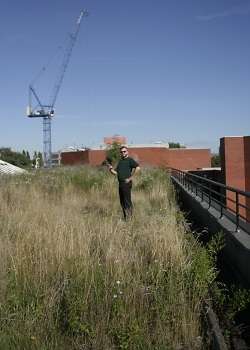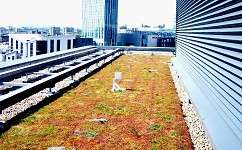The study roof with Dr Speak holding an anenometer
Green roofs could become a future source of water pollution, says a new study.
The research, published in the journal Environmental Pollution, looked at the differences between an established green roof and a conventional roof surface.
Green roofs are known to be efficient at capturing air pollution and until now it was thought that the polluting particles were retained in the soil layer and the vegetation.
This new study, conducted by researchers at the Universities of Manchester and Leicester, suggests that instead, the pollutants can leak out into rainwater as it runs off the roof.
'The rainwater runoff from the green roof was green and yellow in colour, so we sent samples for analysis of the heavy metal and nutrient concentrations,' says Andrew Speak, a PhD student at the University of Manchester and lead author of the study. 'Some heavy metals were found to be quite high. Copper, lead and zinc all exceeded environmental quality standards.'
The raised lead levels, which were high for both the conventional roof and the green roof, led the team to look more deeply into the possible source.
'Part of the drainage was across a glass atrium which has some lead flashing and may have contributed to the levels. But we also took samples of soil, from the green roof, and lifted up slabs of the conventional roof to collect dust and found both were very high in lead,' says Speak.
Without any obvious significant inputs of lead nearby, the researchers think the lead is probably the legacy of leaded petrol cars which has collected over the years, since the roofs were constructed in 1970, long before the phase-out of leaded petrol.
Modern green roofs would have no significant lead input as we've moved towards unleaded petrol.
'The biggest discovery in this paper is that while green roofs do reduce air pollution, the pollution may accumulate and cause a problem in the future with reduced water quality of runoff,' explains Speak.
The researchers recommend that if planners intend to install a green roof, they must pay attention to its location.
'We shouldn't put green roofs next to busy motorways, or inner city motorways, basically anywhere where vehicle derived pollution could affect runoff in the future,' Speak says.
The team also suggest more research should be done into the substrates green roofs use; for example biochar – a type of charcoal – has been shown to reduce nutrients seeping out of soils, and could help mitigate the problem of heavy metals finding their way into water systems.
More information: A.F. Speak, J.J. Rothwell, S.J. Lindley, C.L. Smith (2014) "Metal and nutrient dynamics on an aged intensive green roof," Environmental Pollution, Volume 184, Pages 33-43
Provided by PlanetEarth Online
This story is republished courtesy of Planet Earth online, a free, companion website to the award-winning magazine Planet Earth published and funded by the Natural Environment Research Council (NERC).























